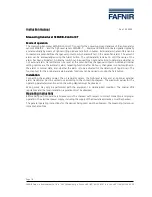
Functional safety for SITRANS P, series DS III PROFIsafe
Product information, 07/2006, A5E00849297-01
B-1
List of Abbreviations/Acronyms
B
B.1
Abbreviations
Abbreviation
Full term in English
Meaning
HFT
Hardware Fault Tolerance
Hardware fault tolerance:
Capability of a function unit to continue executing a required
function in the presence of faults or deviations.
MTBF
Mean Time Between Failures
Average period between two failures
MTTR
Mean Time To Repair
Average period between the occurrence of a fault in a device or
system and the repair
PFD
Probability of Failure on Demand
Probability of dangerous failures of a safety function on demand
PFD
AVG
Average Probability of Failure on
Demand
Average probability of dangerous failures of a safety function on
demand
SIL
Safety Integrity Level
The international standard IEC 61508 defines four discrete
Safety Integrity Levels (SIL 1 to SIL 4). Each level corresponds
to a range of probability for failure of a safety function. The
higher the Safety Integrity Level of the safety-instrumented
system, the lower the probability that it will not execute the
required safety functions.
SFF
Safe Failure Fraction
Proportion of safe failures:
Proportion of failures without the potential to bring the safety-
instrumented system into a dangerous or non-permissible
functional status.
FIT
Failure in Time
Frequency of failure
Number of faults withing 10
9
hours
TI
Test Interval
Testing interval of the protective function
Classification and description of the safety-instrumented system
in terms of redundancy and the selection procedures used.
"Y"
Specifies how often the safety function is executed
(redundancy).
"X"
Determines how many channels have to work correctly.
XooY
"X out of Y" voting
Example:
Pressure measurement: 1oo2 architecture. A safety-
instrumented system decides that a specified pressure limit has
been exceeded if one out of two pressure sensors reaches this
limit. In a 1oo1 architecture, there is only one pressure sensor.






































